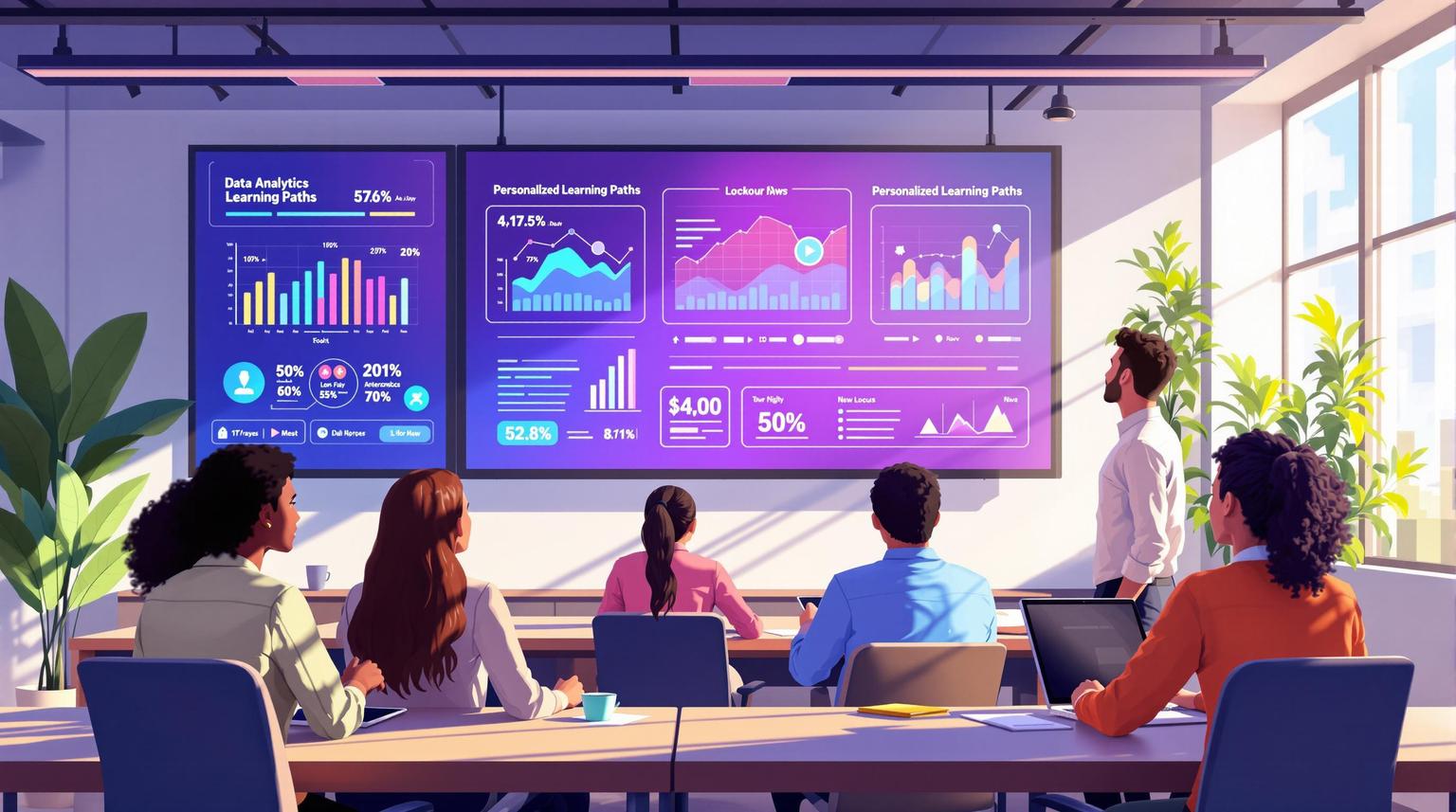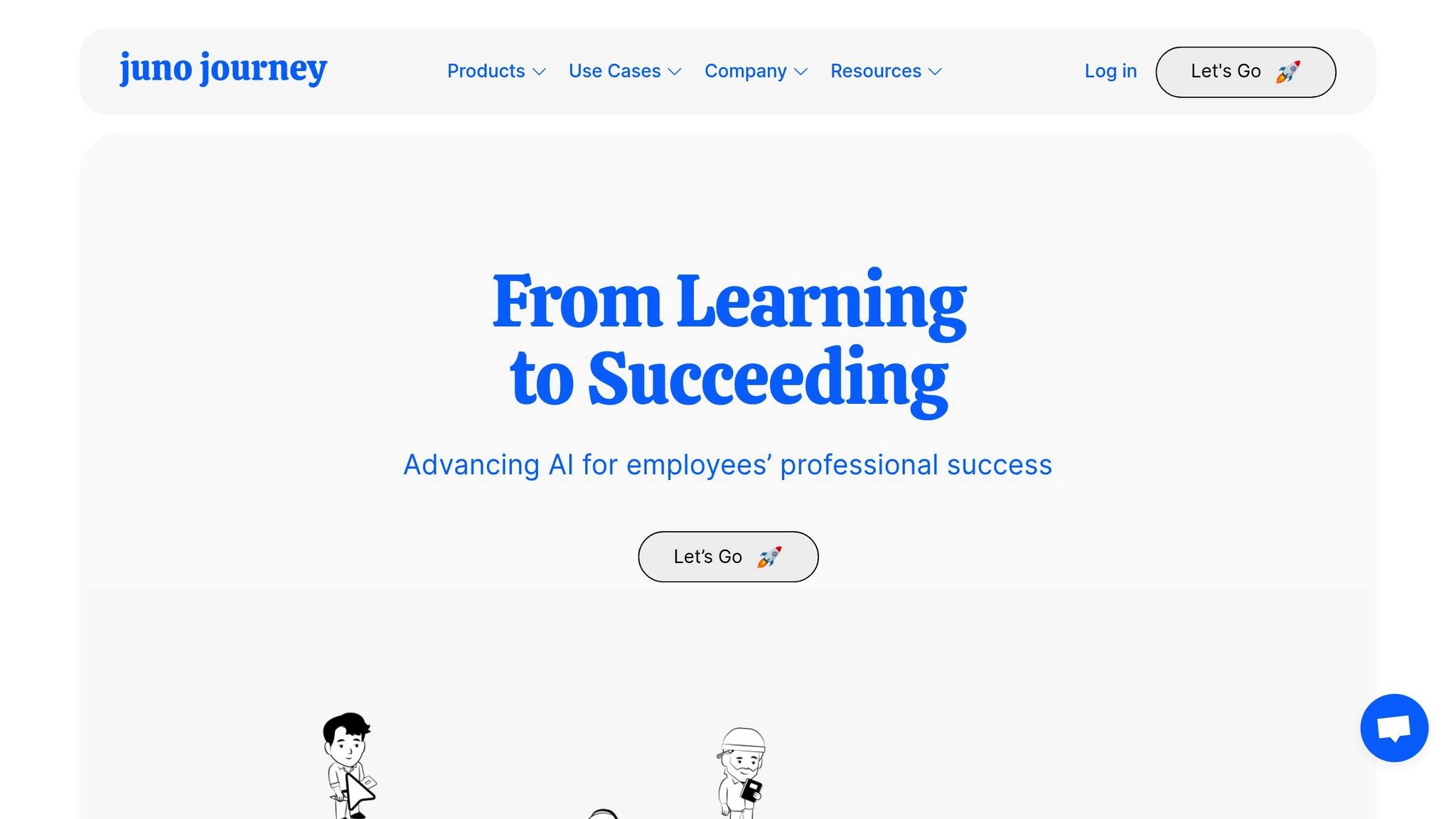
How Predictive Analytics Powers Adaptive Learning Systems
Predictive analytics is transforming workplace training by creating personalized learning paths for employees. Here's how it works:
- Analyzes Data: Tracks user behavior (like completion rates, test scores, and preferences) to predict performance.
- Adapts in Real Time: Uses AI to adjust content delivery based on individual progress and needs.
- Boosts Results: Increases engagement (up to 46%), reduces onboarding time (by 20%), and improves success rates (90%+).
Why It Matters
- For Employees: Tailored learning improves retention and matches skills to goals.
- For Companies: Higher engagement, better efficiency, and measurable ROI.
Modern tools like Juno Journey use these methods to deliver results, such as raising active users from 4% to over 50%. Predictive analytics ensures training is smarter, faster, and more effective for everyone.
Core Components of Predictive Learning Systems
Predictive learning systems rely on effective data gathering, detailed processing, and precise forecasting to create personalized training experiences.
Data Collection Methods
The backbone of predictive analytics in learning platforms is accurate data collection. These systems gather various types of information, including:
| Data Type | Method | Purpose |
|---|---|---|
| User Behavior | Activity tracking | Understanding learning patterns |
| Performance Metrics | Assessments & quizzes | Measuring knowledge retention |
| Engagement Data | Time tracking & interactions | Evaluating content effectiveness |
| Skill Assessments | Role-based evaluations | Identifying gaps in competencies |
The quality of data collection directly impacts the system's ability to improve learning outcomes. This rich dataset serves as the foundation for the next phase of analysis.
Processing Learning Data
AI systems process the collected data to uncover trends and insights. Key tasks during this phase include:
- Identifying patterns in learning behavior and spotting areas where skills are lacking
- Evaluating performance trends and determining the effectiveness of training content
"Using Juno, we were able to bring together all of our internal experts to create a common baseline capturing the core of the payment industry to better all of our employees, regardless of their role. We used Juno's features to enhance employees' learning experiences."
- Ziv Rumack Kazes, Learning & Development @Rapyd
These insights fuel the predictive systems that adapt learning paths to individual needs.
Prediction Systems at Work
After data is collected and analyzed, predictive systems step in to forecast learner needs and potential challenges. For example, Kaltura managed to cut onboarding time and resource use by 20% for 100 remote new hires.
Key predictive features include:
| Feature | Impact | Outcome |
|---|---|---|
| Learning Path Optimization | Better course completion rates | Higher success rates |
| Content Recommendations | Increased engagement | Improved learning experiences |
| Progress Forecasting | Greater participation | More efficient resource allocation |
Creating Custom Learning Paths
Building Personal Learning Routes
Predictive analytics is transforming generic training into personalized learning experiences. By using AI-powered platforms, organizations can analyze learner behavior, performance data, and skill gaps to create tailored development plans that suit individual needs.
Here’s how the process works:
| Component | Function | Benefit |
|---|---|---|
| Goal Alignment | Links personal goals with company objectives | Ensures skills align with business priorities |
| Skill Assessment | Measures current abilities | Pinpoints specific areas for improvement |
| Path Generation | Develops custom learning sequences | Enhances knowledge retention |
| Progress Tracking | Tracks milestones and progress | Allows real-time course adjustments |
These customized paths ensure that learners access the right content at the right time.
Smart Content Delivery
Once these personalized learning routes are in place, AI systems improve content delivery by ensuring the right material is presented at the ideal moment. This approach keeps learners engaged and helps organizations maintain consistent participation.
How does it work? AI systems:
- Analyze individual learning patterns and preferences
- Determine the best timing for delivering content
- Adjust content difficulty based on performance
- Suggest additional resources when necessary
"Juno Journey revolutionized the way we create content, from a push and pull system between employees and managers, to a fully collaborative system. Juno has enabled us to be more connected than ever." - Laura Halonen, Career Development Manager, Flipp
Instant Learning Feedback
In addition to personalized paths and smart content delivery, instant feedback plays a crucial role in keeping learners motivated and informed. Real-time feedback helps learners stay focused and make adjustments as needed.
Here are some key feedback tools:
| Feature | Purpose | Benefit |
|---|---|---|
| Progress Indicators | Display progress toward goals | Keeps learners motivated |
| Performance Analytics | Evaluate learning outcomes | Supports timely adjustments |
| Engagement Metrics | Monitor activity levels | Highlights areas needing attention |
| Achievement Recognition | Celebrate milestones | Encourages course completion |
Real-time feedback has been shown to shorten onboarding times and improve retention. Companies using these predictive learning tools report engagement rates as high as 96%.
sbb-itb-612c355
Tracking Results and Progress
Success Metrics
Modern analytics tools provide in-depth insights into learning and engagement.
| Metric Type | Metrics | Target Goals |
|---|---|---|
| Engagement | Monthly active users, participation rate | 50%+ active users |
| Efficiency | Onboarding time, resource utilization | 20% reduction |
| Performance | Employee success rate, skill acquisition | 90%+ success rate |
| Collaboration | Knowledge sharing, content creation | 46%+ engagement |
One organization, for instance, boosted monthly active users from just 4% to over 50%. Similarly, Kaltura streamlined its remote onboarding process with impressive results.
"We had to onboard 100 new hires remotely and connect them directly with their teams' objectives and workflows. Using Juno's onboarding path, we decreased the time and manpower involved by 20% and were able to finalize the process within a month."
– Hili Bezalel, HR & OD expert @ Kaltura
These metrics help guide adjustments and improvements to the system.
System Optimization
Refining prediction models regularly can improve learning outcomes. Organizations can enhance their platforms by taking a data-driven approach, such as:
- Examining learner behavior patterns
- Spotting trends in content engagement
- Updating prediction models based on results
- Fine-tuning delivery timing for better impact
Careful data analysis is key to these improvements.
Data Ethics and Privacy
While metrics and optimizations are essential, ethical data practices ensure the system remains trustworthy. Protecting learner data is critical to maintaining both performance and integrity.
Privacy Protection Measures:
- Secure storage and transmission of data
- Transparent consent processes
- Anonymous tracking of performance
- Regular privacy reviews and audits
Bias Prevention Strategies:
- Using diverse data sources
- Conducting regular algorithm audits
- Selecting inclusive and varied content
- Providing clear and open reporting
Juno Journey's Predictive Features

Juno Journey uses advanced analytics and system efficiency to offer tailored learning experiences for employees.
AI Learning Path Creation
The platform uses AI to create custom learning paths based on each employee's goals and needs. By analyzing learning data, it organizes courses that align personal development with the company's objectives.
Content Selection System
Juno Journey uses predictive analytics to pair employees with the right learning materials from its network of over 150 content providers. This system focuses on delivering the right resources when they're needed most, targeting three main areas:
| Focus Area | Predictive Capability | Impact |
|---|---|---|
| Role Alignment | Matches content to specific job functions | Develops skills relevant to the role |
| Skill Gaps | Pinpoints learning needs from performance data | Targets areas needing improvement |
| Learning Style | Adjusts content format to fit preferences | Achieves a 96% engagement rate |
Progress Tracking Tools
Juno Journey's tracking tools provide real-time updates on learning outcomes, helping organizations refine their strategies. These tools have delivered measurable results, including a 90% employee success rate, a 46% boost in engagement, and a 20% reduction in onboarding time.
Summary
Next Steps in Learning Tech
Predictive analytics in learning systems is now enabling advanced levels of personalization and automation. Companies using these tools are seeing clear improvements in employee development. For instance, Trax Retail has reported a significant boost in user engagement thanks to these systems. As the technology evolves, real-time analytics will likely play an even bigger role in creating tailored learning experiences. This progress not only enhances learning outcomes but also delivers measurable business benefits.
Business Impact of Predictive Learning
The business advantages of predictive learning are just as impactful as the technology itself. Take Kaltura, for example - by implementing predictive learning paths, they managed to cut onboarding time and resource use by 20% for 100 remote new hires. This shift to data-driven training methods is reshaping how organizations collaborate and learn. Key benefits include:
- Increased employee success rates
- Higher engagement levels
- Lower administrative workload
- Better cross-team knowledge sharing
These examples highlight how predictive analytics is transforming learning strategies while boosting organizational growth and efficiency. Beyond improving individual performance, this technology fosters stronger team collaboration and long-term operational gains.